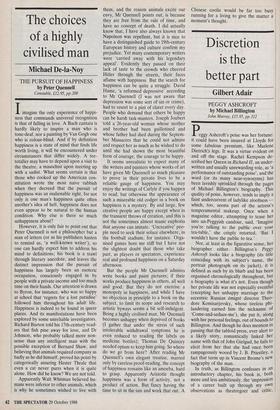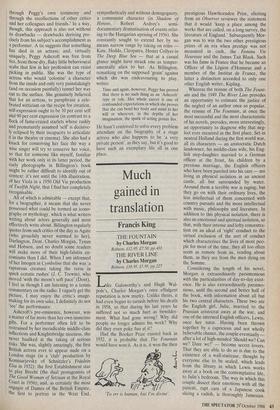Discretion is the better part
Gilbert Adair
PEGGY ASHCROFT by Michael Billington John Murray, .£15.95, pp.312 Peggy Ashcroft's poise was her fortune: it could have been insured at Lloyds for some fabulous premium, like Marlene Dietrich',s legs. It was a virtue evident on and off the stage. Rachel Kempson de- scribed her Queen in Richard 11, an under- written and usually unrewarding role, as 'a performance of outstanding poise', and the word (or its many near-synonyms) has been lavishly sprinkled through the pages of Michael Billington's biography. This quality of poise, however, tends to imply a faint undercurrent of ladylike aloofness which, too, seems part of the actress's temperamental makeup. Once when a magazine editor, attempting to tease her into un-Peggyish candour, said, 'Imagine you're talking to the public over your tea-table,' she crisply retorted, 'But I wouldn't have the public to tea.'
Nor, at least in the figurative sense, her biographer either. Billington's Peggy Ashcroft looks like a biography (its title coinciding with its subject's name, the portrait photograph on its jacket), it is defined as such by its blurb and has been organised chronologically throughout, but a biography is what it's not. Even though her private life was not especially eventful (excepting her unhappy marriage to the eccentric Russian émigré director Theo- dore Komisarjevsky, whose tireless phi- landering earned him the nickname of `Come-and-seduce-me'), she put it, along with her personal feelings, out of bounds to Billington. And though he does mention in passing that the tabloid press, ever alert to a likely story, romantically linked her name with that of John Gielgud, he fails to elicit from her that she had once been rampageously wooed by J. B. Priestley, a fact that turns up in Vincent Brome's new biography of the man. In truth, as Billington confesses in an introductory chapter, his book is, both more and less ambitiously, the 'impression of a career built up through my own observations as theatregoer and critic, through Peggy's own testimony and through the recollections of other critics and her colleagues and friends.' In a way, though, this approach is also not without its drawbacks — drawbacks deriving pre- cisely from his subject's accomplishment as a performer. A tic suggests that something has died in an actress; and, virtually uniquely, Peggy Ashcroft was free from tics, from those dry, flaky little behavioural scabs that few in her profession can resist picking in public. She was the type of actress who would 'colonise' a character from the inside and only very painstakingly (and on occasion painfully) tunnel her way out to the surface. She genuinely believed that for an actress, to paraphrase a cele- brated witticism on the recipe for creation, self-expression ought to be 10 per cent self and 90 per cent expression (in contrast to a flock of fame-crazed starlets whose rashly and prematurely assumed 'self is decisive- ly eclipsed by their incapacity to articulate it in the theatre or cinema). She also had a knack for conserving her face the way a wise singer will try to conserve her voice, so that for someone like myself, familiar with her work only in its latter period, the early photographs in Billington's book might be rather difficult to identify out of context: it's not until the 14th illustration, of her Viola in a 1950 Old Vic production of Twelfth Night, that I find her completely recognisable.
All of which is admirable — except that, for a biographer, it means that she never possessed what could be termed an icono- graphy or mythology, which is what writers writing about actors generally and most effectively write about. Billington regularly quotes from such critics of the day as Agate (who grouchily never warmed. to her), Darlington, Dent, Charles Morgan, Tynan and Hobson, and no doubt some readers will make more of their high-falutin en- comiums than I did. When I am informed of her Imogen in Cymbeline that she was 'a rapturous creature taking the verse in quick ecstatic rushes' (J. C. Trewin), who moved 'with the moon's soft pace' (Dent), I feel as though I am listening to a tennis commentary on the radio: I vaguely get the picture, I may enjoy the critic's image- making for its own sake, I definitely do not `see' the performance.
Ashcroft's pre-eminence, however, was a matter of far more than her own immense gifts. For a performer often felt to be restrained by her ineradicable middle-class inflections and Knightsbridge niceness, she never baulked at the taking of serious risks. She was, slightly amazingly, the first British actress ever to appear nude on a London stage (in a 'club' production by Komisarjevsky of Schnitzler's Fraulein Elsa in 1932); the first Establishment star to play Brecht (the dual protagonists of The Good Woman of Setzuan at the Royal Court in 1956); and, as certainly the most engagee of Dames of the British Empire, the first to portray in the West End,
sympathetically and without demagoguery, a communist character (in Shadow of Heroes, Robert Ardrey's semi- documentary dramatisation of events relat- ing to the Hungarian uprising of 1956). She constantly sought to extend her by no means narrow range by taking on roles Kate, Hedda, Cleopatra, Hester Collyer in The Deep Blue Sea — that at a casual glance might have struck one as temper- amentally alien to her. As Billington, remarking on the supposed 'grain' against which she was endeavouring to play, writes:
Time and again, however, Peggy has proved that there is no such thing as an 'Ashcroft' type or role. Her whole career is one of confounded expectations in which she proves that she can bend her body and mind to her will or wherever, in the depths of her imagination, the spark of acting genius lies.
He hasn't contrived to solve every problem attendant on the biography of a stage actress who also happens to be 'a very private person', as they say, but it's good to have such an exemplary life all in one place.



























































 Previous page
Previous page